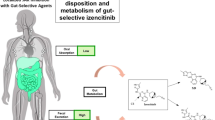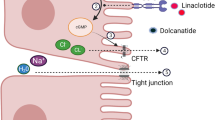Abstract
Purpose. To identify regions of the rat intestine that are able to internalize from the lumen oligopeptides, using the model drug glatiramer acetate (GA).
Methods. GA was introduced into rat intestinal sacs and the integrity of GA during uptake was monitored using antibody detection. Sodium docecyl sulphate polyacrylamide gel electrophoresis (SDS-PAGE) and immunoblotting of intestinal homogenates that had been exposed to GA were performed to identify GA presence. An enzyme-linked immunosorbent assay (ELISA) protocol was adapted for GA quantification. Immunohistochemistry was undertaken to examine the rat colonic wall for GA uptake, and confocal microscopy was used to differentiate adsorbed and internalized peptide in cultured colorectal adenocarcinoma cells.
Results. The colon and the ileum, respectively, were identified to be the intestinal regions in which GA was maximally preserved during uptake from the lumen. GA was identified to cross the colonic wall from the epithelium to the serosa. Internalization of GA into cultured colonic epithelial cells was demonstrated.
Conclusions. The rat colonic wall was identified to be less proteolytically active toward GA compared to the wall of the more proximal regions of the small intestine. GA has the capacity to penetrate from the lumen into the colonic wall. The maintenance of GA integrity within the wall of the colon offers the potential for local biological activity of the drug.
Similar content being viewed by others
REFERENCES
J. F. Woodley. Enzymatic barriers for GI peptide and protein delivery. Crit. Rev. Ther. Drug Carrier Syst. 11:61–95 (1994).
B. G. Arnason. Immunologic therapy of multiple sclerosis. Annu. Rev. Med. 50:291–302 (1999).
D. Teitelbaum, R. Arnon, and M. Sela. Immunomodulation of experimental autoimmune encephalomyelitis by oral administration of copolymer 1. Proc. Natl. Acad. Sci. U S A 96:3842–3847 (1999).
D. M. Weir. Labelling Proteins and Polypeptides, 2nd edition, Blackwell Scientific, Abingdon, Oxon, United Kingdom 1973.
L. Barthe, J. Woodley, and G. Houin. Gastrointestinal absorption of drugs: Methods and studies. Fundam. Clin. Pharmacol. 13:154–168 (1999).
A. A. Abbas, A. H. Lichtman, and J. S. Pober. Cellular and Molecular Immunology. W.B. Saunders Co., Philadelphia, London, Toronto, 1994.
R. L. Bacon and N. R. Niles. Medical Histology, Springer-Verlag, New York, Heidelber, Berlin, 1983.
P. Onori, A. Franchitto, R. Sferra, A. Vetuschi, and E. Gaudio. Peyer's patches epithelium in the rat: A morphological, immunohistochemical, and morphometrical study. Dig. Dis. Sci. 46:1095–1104 (2001).
A. Rubinstein, B. Tirosh, M. Baluom, T. Nassar, A. David, I. Gliko-Kabir, R. Radai, and M. Friedman. The rationale for peptide drugs delivery to the colon and the potential of polymeric carriers as effective tools. J. Control. Release 46:59–73 (1997).
W. Wang. Oral protein drug delivery. J. Drug Target. 4:195–232 (1996).
K. Ikesue, P. Kopeckova, and J. Kopecek. Degradation of proteins by Guinea pig intestinal enzymes. Int. J. Pharm. 95:171–179 (1993).
R. H. Lu, P. Kopeckova, and J. Kopecek. Degradation and aggregation of human calcitonin in vitro. Pharm. Res. 16:359–367 (1999).
Y. Sai, M. Kajita, I. Tamai, J. Wakama, T. Wakamiya, and A. Tsuji. Adsorptive-mediated endocytosis of a basic peptide in enterocyte-like Caco-2 cells. Am. J. Physiol. 275:G514–G520 (1998).
Y. Sai, M. Kajita, I. Tamai, J. Wakama, T. Wakamiya, and A. Tsuji. Adsorptive-mediated transcytosis of a synthetic basic peptide, 001-C8 in Caco-2 cells. Pharm. Res. 15:1305–1309 (1998).
M. Heyman, A. M. Crain-Denoyelle, S. K. Nath, and J. F. Desjeux. Quantification of protein transcytosis in the human colon carcinoma cell line CaCo-2. J. Cell. Physiol. 143:391–395 (1990).
J. A. Atchison, W. E. Grizzle, and D. J. Pillion. Colonic absorption of insulin: an in vitro and in vivo evaluation. J. Pharmacol. Exp. Ther. 248:567–572 (1989).
Y. Zheng, Y. Qiu, M. F. Lu, D. Hoffman, and T. L. Reiland. Permeability and absorption of leuprolide from various intestinal regions in rabbits and rats. Int. J. Pharm. 185:83–92 (1999).
L. Steidler, W. Hans, L. Schotte, S. Neirynck, F. Obermeier, W. Falk, W. Fiers, and E. Remaut. Treatment of murine colitis by Lactococcus lactis secreting interleukin-10. Science 289:1352–1355 (2000).
L. Y. Xu, J. S. Yang, Y. M. Huang, M. Levi, H. Link, and B. G. Xiao. Combined nasal administration of encephalitogenic myelin basic protein peptide 68-86 and IL-10 suppressed incipient experimental allergic encephalomyelitis in Lewis rats. Clin. Immunol. 96:205–211 (2000).
Author information
Authors and Affiliations
Corresponding author
Rights and permissions
About this article
Cite this article
Haupt, S., Gil, E., Tirosh, R. et al. Regional Peptide Uptake Study in the Rat Intestinal Mucosa: Glatiramer Acetate as a Model Drug. Pharm Res 19, 832–837 (2002). https://doi.org/10.1023/A:1016109016942
Issue Date:
DOI: https://doi.org/10.1023/A:1016109016942




